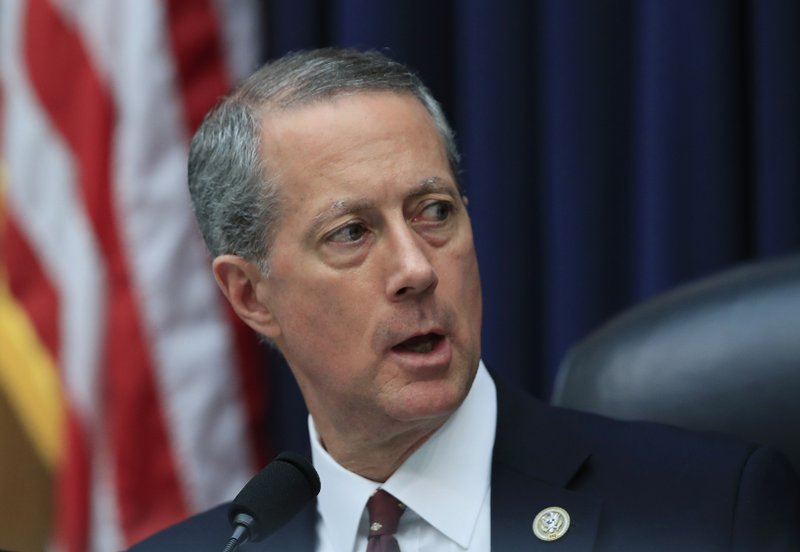WASHINGTON -- Declaring the U.S. military in dire need of rebuilding, an influential House committee chairman pressed his case Monday for $696 billion defense budget in 2018 -- more military spending than at any point during the wars in Iraq and Afghanistan.
Rep. Mac Thornberry, R-Texas, who heads the House Armed Services Committee, argued that the sharp increase is badly needed to address shortcomings that have driven the combat readiness of the armed forces to a level Defense Secretary James Mattis has described as shocking.
"Today, we have too many planes that cannot fly, too many ships that cannot sail, too many soldiers who cannot deploy, while too many threats are gathering," Thornberry said.
His blueprint is $28.5 billion above the $603 billion that President Donald Trump requested for core Pentagon operations, along with just under $65 billion for warfighting missions. Thornberry said his plan addresses key areas such as aviation, ground forces and missile defense that Trump "neglected" in the budget proposal he submitted to Congress last month.
Thornberry's blueprint, which will be considered by the Armed Services Committee on Wednesday, would supply $2.5 billion more than the nearly $10 billion Trump sought for missile defense programs. Thornberry said last week that he was "astonished" by the shortfall in Trump's request, citing the potential threat the U.S. faces of a missile strike by North Korea or Iran.
The chairman's plan also would buy 87 F-35 Joint Strike Fighters, 17 more than Trump asked for, as well as four additional V-22 tilt-rotor aircraft and eight F/A-18 jet fighters. He also wants to acquire additional ships for the Navy. The Army would get more upgraded Abrams tanks and Bradley Fighting Vehicles.
Thornberry has been at odds with fellow Republicans over how much the Pentagon should get in the fiscal year beginning Oct. 1. He told reporters last week that he wanted a 2018 defense budget of $705 billion. But he shaved $8.5 billion from his plan amid discussions with leaders of the House budget and appropriations committees over defense spending levels.
Conservatives who dominate the Budget Committee agreed last week on a budget outline that promises $20 billion less than Thornberry envisioned for the core military budget that pays for weapons, training and troop salaries.
Thornberry told reporters last week that he would be willing to accept a lower overall budget number, but only if he's assured the Pentagon will no longer be hamstrung by a herky-jerky budgeting process that leaves the armed services unsure of how much they'll get each year and when the money will arrive. His plan released Monday doesn't say what assurances, if any, Thornberry received.
Squarely in the sights of Thornberry and other defense hawks on Capitol Hill is a 2011 law that strictly limits defense spending. If the budget caps mandated by the Budget Control Act are breached, automatic spending reductions known as sequestration are triggered. They've been pushing for the law to be repealed, but they'll need help from Democrats who want limits on domestic spending erased.
Thornberry criticized Trump's maiden Pentagon budget as inadequate, but he refused to blame the president for the shortcomings. The defense budget sent to Congress last month was essentially what former President Barack Obama would have proposed, he said.
"There wasn't anybody at DOD to write a Trump budget request," according to Thornberry. "I have no doubt that our president wants to repair and rebuild our military."
The Trump administration is almost entirely responsible for the skeleton crew at the Pentagon. There are dozens of top-level jobs that require Senate confirmation before they can be filled, but Trump, in office since late January, has nominated just 20 so far. Six have been confirmed, including Mattis, while a dozen or so others await approval, according to figures maintained by the Senate.
Thornberry's blueprint recommends an increase of 10,000 active duty troops for the Army, which would bring the service to 486,000 full-time troops.
The plan also provides a 2.4 percent pay raise for service members, which is slightly higher than the wage increase the Pentagon had proposed. Mattis defended the lower amount during a committee hearing earlier this month, telling lawmakers that the salaries of U.S. service members are competitive with the private sector.
A Section on 06/27/2017
